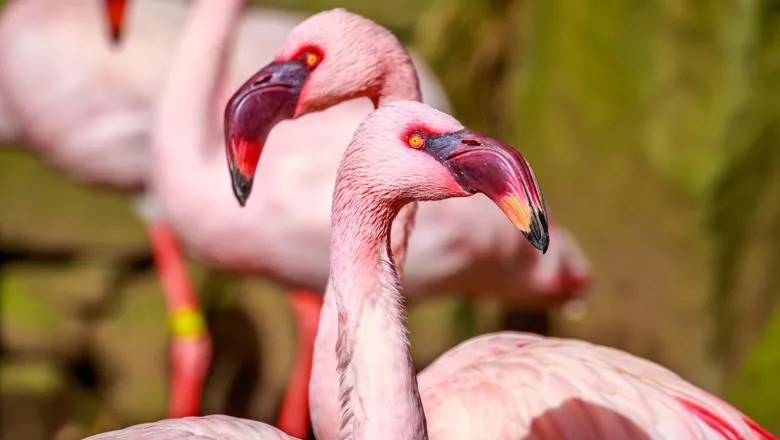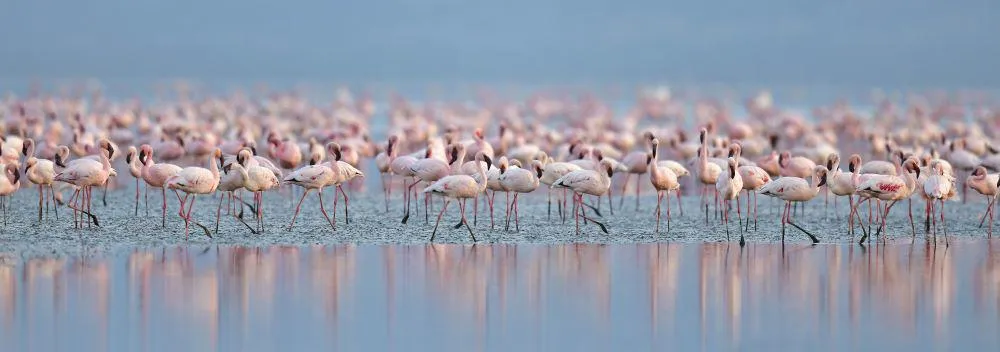Increased rainfall is diluting saltwater habitats, leading to a decline in birds' phytoplankton prey

New research led by King's College London has revealed how the Lesser Flamingo is in danger of being flushed from its historic feeding grounds, with serious consequences for the future of the species.
For the first time, satellite earth observation data has been used to study all of the key flamingo feeding lakes in Ethiopia, Kenya and Tanzania over two decades, which identified how rising water levels are reducing the birds' main food source.
The authors warn the birds are likely to be pushed into new unprotected areas in the search for food, especially given predicted higher levels of rainfall linked to climate change.
They are now calling for coordinated conservation action across international borders, improved monitoring and more sustainable management of land surrounding important flamingo lakes.
Lead author Aidan Byrne, a PhD student jointly supervised by King's Department of Geography and the Natural History Museum, said the region was home to more than three quarters of the global population of Lesser Flamingos, but their numbers are declining.
Lesser Flamingos in East Africa are increasingly vulnerable, particularly with increased rainfall predicted for the region under climate change. Without improved lake monitoring and catchment management practices, the highly specialised species found in soda lake ecosystems - including Lesser Flamingos - could be lost.
Aidan Byrne, PhD Student, KCL and NHM
The study, published in the journal Current Biology, is the first in which satellite earth observation data has been used to study all 22 key flamingo feeding soda lakes in East Africa. This analysis was combined with climate records and bird observation data over more than two decades.
By studying on this large scale for the first time, researchers were able to see changing food availability across the whole network of lakes, including significant declines in recent years, and how bird numbers decreased as lake surface area increased. They also identified the lakes the birds might move to in the future.
Co-author, Dr Emma Tebbs, from King's College London said whilst flamingos naturally travel in search of food, the degradation of their historic feeding and breeding sites was a serious concern.
"East African populations could potentially move north or south away from the equator in search of food resources. And whilst six study lakes increased in habitat suitability from 2010 to 2022, only three of those have some level of conservation protection.
"Increases in water levels could lead to lesser flamingos becoming more reliant on lakes that are unprotected, outside of current nature reserves and protected sites, which has implications for conservation and ecotourism revenues."

Soda lakes are some of the harshest environments on Earth, being both highly saline and very alkaline. Despite this, many species have evolved to thrive in these conditions, including the flamingo and its phytoplankton prey, which they filter from the water using their sieve-like beaks.
The research found rising water levels across the region's soda lakes were diluting their normally salty and alkaline nature, leading to a decline in populations of phytoplankton, which was measured by the amount of a photosynthetic pigment called chlorophyll-a present in the lakes.
The team found that phytoplankton levels have been declining over the 23 years of study and linked this to increases in the surface areas of the lakes over the same period.
The largest losses in phytoplankton biomass occurred in the equatorial Kenyan lakes, notably at the important tourist lakes of Bogoria, Nakuru and Elmenteita, and in the northern Tanzanian lakes that saw the largest increases in surface area.
Nakuru is one of the most important flamingo feeding lakes in East Africa, historically supporting over one million birds at a time. The lake increased in surface area by 91% from 2009 to 2022 whilst its mean chlorophyll-a concentrations halved.
Natron in Tanzania is the only regular breeding site for Lesser Flamingos in East Africa and it has experienced declining productivity alongside rising water levels in recent years. If phytoplankton biomass continues to decline there and at other nearby feeding lakes, it will no longer be a suitable breeding site.
In addition to scientists from the Department of Geography, King's College London and the Natural History Museum, the team also included researchers from National Museums of Kenya, the Tanzania Wildlife Research Institute, the Zoological Society of London, the University of Leicester, and the Freshwater Biological Association.








